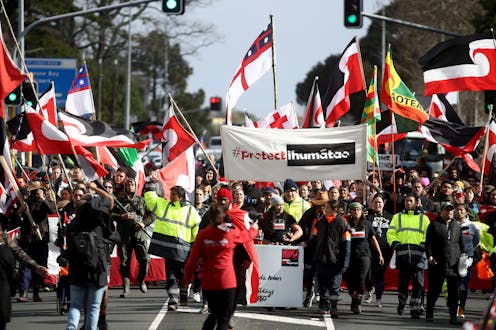4 fundamental questions media can ask themselves when covering stories about Māori
- Written by Angela Moewaka Barnes, Senior researcher, Massey University

There is little evidence to suggest Aotearoa New Zealand’s mainstream news media critically evaluate their own reporting on issues about or affecting Māori and te Tiriti o Waitangi (Treaty of Waitangi). This is concerning, given the negative framing[1] of so much coverage, past and present.
The one exception to this general ambivalence has been the groundbreaking apology[2] in 2020 by digital and print news organisation Stuff for a long history of monocultural and Eurocentric bias.
Informed by our research on how news about Māori and te Tiriti is often constructed[3], Stuff looked back at its legacy mastheads and found stories that ranged from “blinkered to racist[4]”. It pledged to change and improve to reflect a commitment to Māori audiences and the principles of te Tiriti.
To date, no other media organisation has attempted to evaluate its reporting in this way – or, in fact, acknowledge this might be necessary. But media funding agency New Zealand on Air now offers a Tiriti Framework For News Media[5], also based on our research, to guide organisations applying to its public interest journalism fund[6].
It is hoped the framework will help media organisations develop strategies that promote more accountable and equitable practices in their day-to-day reporting and commentary.
Colonial and settler narratives
The initiative is important because news is not some objective truth waiting to be reported. It is constructed through the lenses of news teams – and particularly senior journalists and editors – who are predominantly Pākehā[7].
The types of stories that are told, and the way people and subjects are represented, involve deliberate choices. This frequently means few Māori stories are told. And when Māori are represented, they can be framed in limiting and negative ways.
Historically, this is common to news and media representations of Indigenous peoples everywhere. There is undoubtedly bias at work some of the time. But as we have argued[8] previously, these “negative ‘stories’ and representations of Indigenous peoples are strategic; tactical necessities rather than aberrations”.
Read more: Indigenous knowledge is increasingly valued, but to fully respect it we need to decolonise science – here's how[9]
In other words, they “play important roles in the ongoing colonial project, enhancing the legitimisation and naturalisation of the institutions, practices, and priorities of the colonising state”.
Early European colonists in the South Pacific founded newspapers and published material to serve their interests, institutionalising their preferred social order and norms. For example, an early handbook[10] from the New Zealand Company[11] in 1839 – “Information Relative to New Zealand, Compiled for the use of Colonists” – included some of the first representations of Māori as savage and lawless.
Settler newspapers recycled these themes from 1840 onwards. Variations of the same message persist to the present day. Recent research shows that in countries colonised by Britain, news consistently represents[12] Indigenous peoples as violent, primitive and untrustworthy.
Read more: How to decolonize journalism — Podcast[13]
Fundamental questions
Contemporary coverage of Māori activism still routinely misinforms and fails to capture nuance. Reporting of the 2020 Ihumātao occupation, for example, frequently reduced internal tensions to a clash between young and old[14].
Similarly in Australia, the debate over the proposed First Nations Voice to Parliament[15] has seen the spread of disinformation[16] attempting to equate the policy with apartheid.
On the other hand, there is evidence that both journalists[17] and their audiences[18] want to see change. This is where the new media framework can make a difference. It provides detailed examples of more equitable news practices, and prompts news organisations to ask themselves several fundamental questions:
Commitment to te Tiriti: how do you enact responsibilities under He Whakaputanga[19] and te Tiriti?
Societal accountabilities: how do you transform use of harmful, racist themes and narratives around Māori?
News media practices: who benefits from the kinds of stories you choose to tell?
Māori-controlled media: how do you represent diversity in Māori stories and in your own staffing?
Read more: Included, but still marginalised: Indigenous voices still missing in media stories on Indigenous affairs[20]
Challenge and opportunity
We’ve seen some positive responses to the framework, as well as accusations that the Tiriti requirements of New Zealand on Air’s public interest journalism fund amount to “propaganda[21]” that muzzles mainstream media.
Either way, media organisations are now operating in an environment where profit models require innovation, with increasing competition from social media and changes in audience behaviours.
While this is challenging, it also offers an opportunity to transform journalism and improve newsroom practices. The Stuff and New Zealand on Air initiatives show how it’s possible to tackle harmful representations of Māori in mainstream news media.
Our framework could also be adapted to other sectors and settings where systemic bias and disadvantage are felt. For now, though, it is up to media organisations, funders and policymakers to decide how they will respond.
The authors acknowledge Dr Jenny Rankine and Dr Ray Nairn who were authors on Te Tiriti Framework For News Media and contributed to this article.
References
- ^ negative framing (trc.org.nz)
- ^ groundbreaking apology (www.stuff.co.nz)
- ^ often constructed (trc.org.nz)
- ^ blinkered to racist (www.theguardian.com)
- ^ Tiriti Framework For News Media (d3r9t6niqlb7tz.cloudfront.net)
- ^ public interest journalism fund (www.nzonair.govt.nz)
- ^ predominantly Pākehā (www.stuff.co.nz)
- ^ we have argued (trc.org.nz)
- ^ Indigenous knowledge is increasingly valued, but to fully respect it we need to decolonise science – here's how (theconversation.com)
- ^ early handbook (natlib.govt.nz)
- ^ New Zealand Company (nzhistory.govt.nz)
- ^ consistently represents (trc.org.nz)
- ^ How to decolonize journalism — Podcast (theconversation.com)
- ^ clash between young and old (thespinoff.co.nz)
- ^ First Nations Voice to Parliament (www.reconciliation.org.au)
- ^ disinformation (theconversation.com)
- ^ journalists (ir.canterbury.ac.nz)
- ^ audiences (www.tandfonline.com)
- ^ He Whakaputanga (nzhistory.govt.nz)
- ^ Included, but still marginalised: Indigenous voices still missing in media stories on Indigenous affairs (theconversation.com)
- ^ propaganda (theplatform.kiwi)
















